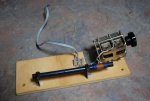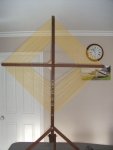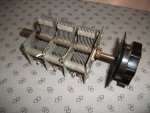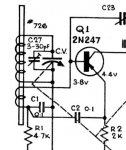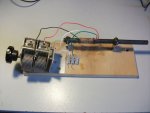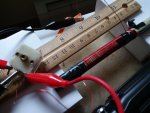Thanks Forum community for opportunity to post, first time.
My eventual goal is to use this antenna in a DIY MW/LW receiver project, with the TA 7642 AM radio IC.
This is my first DIY antenna, 120 turns of 28 AWG enameled copper wire, on a 135 x 10mm ferrite bar. The twisted antenna wires get plugged in to external AM antenna jack on stereo. Without the variable capacitor (141.6 pF yellow lead, black lead ground to copper baseboard water pipe, red lead 59.2 pF), I barely get signal. With the variable capacitor configuration, the antenna's performance is much better, but half that of the cheap, 5", 8-loop coil AM antenna (left). Performance is the same switching yellow and red leads. The signal is best across the spectrum when the capacitor tuning knob is fully counter-clockwise. The extra capacitor is to show you the back.
My goal in getting this large ferrite bar is to make a MW/LW beast with impressive reception. So thanks in advance for guidance.
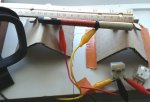
My eventual goal is to use this antenna in a DIY MW/LW receiver project, with the TA 7642 AM radio IC.
This is my first DIY antenna, 120 turns of 28 AWG enameled copper wire, on a 135 x 10mm ferrite bar. The twisted antenna wires get plugged in to external AM antenna jack on stereo. Without the variable capacitor (141.6 pF yellow lead, black lead ground to copper baseboard water pipe, red lead 59.2 pF), I barely get signal. With the variable capacitor configuration, the antenna's performance is much better, but half that of the cheap, 5", 8-loop coil AM antenna (left). Performance is the same switching yellow and red leads. The signal is best across the spectrum when the capacitor tuning knob is fully counter-clockwise. The extra capacitor is to show you the back.
My goal in getting this large ferrite bar is to make a MW/LW beast with impressive reception. So thanks in advance for guidance.

Last edited:


